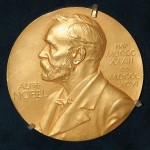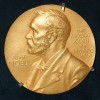Ribosome Discoveries Recognized in 2009 Nobel Prize in Chemistry
 The 2009 Nobel Prize in Chemistry will be shared between Venkatraman Ramakrishnan, Thomas A. Steitz and Ada E. Yonath for discovering how ribosomes function at the atomic level.
The 2009 Nobel Prize in Chemistry will be shared between Venkatraman Ramakrishnan, Thomas A. Steitz and Ada E. Yonath for discovering how ribosomes function at the atomic level.
Ribosomes are molecular machines composed of RNA and protein that perform the critical function of translating messenger RNA (mRNA) into protein. In other words, they transform the genetic code from a static list of instructions into dynamic entities that constitute life. As the Nobel Foundation’s announcement eloquently put it, “they build and control life at the chemical level.”
In a tour-de-force of atomic chemistry, Ramakrishnan, Steitz, and Yonath used X-ray crystallography to locate each of the several hundred-thousand atoms that make up the ribosome and generated 3-D models of antibiotics binding to the structure. These models promise to spur the development of new antibiotics, which are so critical to modern medicine. Ultimately, they will have a critical impact in reducing suffering and mortality worldwide.
Check out our ribosome game here.
Venkatraman Ramakrishnan was born in India in 1952. He is the Senior Scientist and Group Leader at Structural Studies Division, MRC Laboratory of Molecular Biology, Cambridge, UK.
Thomas Steitz was born in Milwaukee in 1940. He is the Sterling Professor of Molecular Biophysics and Biochemistry and Howard Hughes Medical Institute Investigator, at Yale University.
Ada E. Yonath was born in Israel in 1939. She is Director of the Helen & Milton A. Kimmelman Center for Biomolecular Structure & Assembly, at Weizmann Institute of Science, Israel.
| Print article | This entry was posted by connolly on October 7, 2009 at 9:57 am, and is filed under DNA From The Beginning. Follow any responses to this post through RSS 2.0. You can skip to the end and leave a response. Pinging is currently not allowed. |


